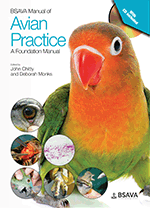
Full text loading...

Weakness and seizures are often the result of a chronic disease process. In cases of weakness without accompanying specific clinical signs, it is not always easy to decide which diagnostic measure is appropriate. It is important to be aware of the range of possible neurological disorders underlying weakness. This chapter provides a guideline for immediate life saving measures and a possible step-by-step diagnostic workup. Case examples: Amazon parrot with lead toxicosis; Liver failure in an Indian Hill Mynah; Heart disease in an African Grey Parrot; Weakness in a wild Common Buzzard.
Weakness and seizures, Page 1 of 1
< Previous page | Next page > /docserver/preview/fulltext/10.22233/9781910443323/9781910443323.32-1.gif

Full text loading...



